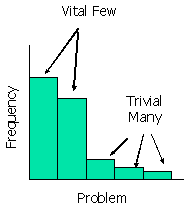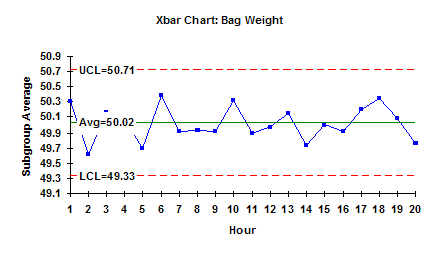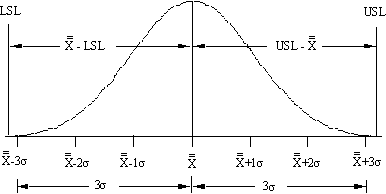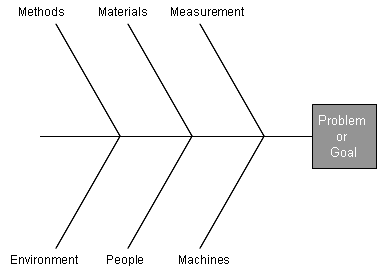August 2008
In this issue:
- Variation
- Dr. W. Edwards Deming
- Control Charts
- Bar Charts
- Measurement Systems Analysis
- Process Capability
- Root Cause Analysis
- Miscellaneous
- Feedback
- Quick Links
Greetings!
Since January 2004 we have been publishing a monthly newsletter that covers a topic related to SPC. One of our objectives has been to make the website a place where people can go for information on SPC and related topics. We believe our newsletters have helped us reach this objective. Over time, the number of newsletter subscribers has risen from about 50 to 6,000.
This month we think it is time to review our past newsletter topics to let the many new users know what is available. There is a lot of information and knowledge in our newsletters. Many contain example data and solutions. All our past newsletters are available online. Please enjoy this review and visit our website to read the past newsletters. The review is divided into the topics shown above.
We also want to know what you would like to see for future topics. Please email us with your suggestions.
We are also happy to announce the release of the 4th version of SPC for Excel set for September 2008. Please check out this version’s new features that are described in the last section of this newsletter.
Best regards,
Bill
Variation

- Variation (January 2004)
- Leadership and Variation (February 2004)
- Revisiting Variation (March 2006)
- Overcontrolling a Process: The Funnel Experiment (July 2006)
- Revisiting Variation (January 2008)
Dr. W. Edwards Deming

Dr. Deming spent years developing a theory for helping companies move forward into the twenty-first century. Remarkably, it all still applies today. Understanding Dr. Deming begins with understanding his “system of profound knowledge.” This system is composed of four bodies of knowledge:
- Knowledge of a system
- Knowledge of variation
- Theory of knowledge
- Knowledge of psychology
To understand the system of profound knowledge, you must understand what a system is and what the “aim” of a system is. You must also understand variation and realize that the true benefit of this understanding comes from how you lead people. You must understand the theory of knowledge, and finally you must understand motivation and psychology. You don’t have to be an expert in each of these areas. However, you must know something about each area because they are interrelated. Our four-part series addresses each of the bodies of profound knowledge.
- Dr. Deming and Profound Knowledge – Part 1 (October 2006)
- Dr. Deming and Profound Knowledge – Part 2 (November 2006)
- Dr. Deming and Profound Knowledge – Part 3 (December 2006)
- Dr. Deming and Profound Knowledge – Part 4 (January 2007)
Control Charts
Control charts, of course, are the workhorse of statistical process control and represent the topic of many of our newsletters. A control chart is a movie of your process over time. It is the way that your process communicates with you. The control chart will tell you if everything is working as the process was designed (just common cause variation present) or if there is a problem (special cause variation present). All you have to do is listen. To listen, you must be able to interpret a control chart. This was the first of our newsletters on control charts.
The newsletters have covered three attributes charts (c, p and u) as well as two variables charts (Xbar-R and X-mR). With the attribute data, we covered how to handle the case when you have small sample sizes for the p and c charts. We also had a three-part series on rational subgrouping for the Xbar-R charts. But there have been many other topics as well, including how to use control charts effectively, what it means to be in statistical control, how to select the right control chart, what to do when the chart is out of control (control strategies) and how to handle chunky and rare event data. Finally, we showed how SPC can be used in a warehouse for process improvement as well as for on-time delivery.
- Interpreting Control Charts (April 2004)
- c Control Charts (July 2004)
- Control Strategies (August 2004)
- Use of Control Charts (January 2005)
- Xbar-R Charts – Part 1 (March 2005)
- Xbar-R Charts – Part 2 (April 2005)
- Rational Subgrouping and Xbar-R Charts (May 2005)
- Rational Subgrouping and Xbar-R Charts – Part 2 (June 2005)
- p Control Charts (July 2005)
- The Impact of Statistical Control (February 2006)
- Selecting the Right Control Chart (April 2006)
- Monitoring Customer Complaints Using SPC (June 2006)
- Individuals Control Charts (October 2006)
- Chunky Data and Control Charts (April 2007)
- Rare Events and X-mR Charts (May 2007)
- SPC and On-Time Performance (June 2007)
- u Control Charts (July 2007)
- SPC & Process Improvement in the Warehouse (August 2007)
- Small Sample Case for p and np Control Charts (February 2008)
- Small Sample Case for c and u Control Charts (March 2008)
Bar Charts

- Pareto Diagrams (June 2004)
- Histograms – Part 1 (December 2005)
- Histograms – Part 2 (January 2006)
Measurement Systems Analysis/Gage R&R
Collecting and analyzing data are a vital part of process improvement. It is important to be sure that the data we are collecting are accurate and precise. Our first newsletter on test methods examined how to use control charts to monitor the measurement system. We also have a four-part series on the variables measurement system that covers stability, bias, linearity, and gage R&R.
- Monitoring Test Methods Using SPC (May 2006)
- Variables Measurement Systems – Part 1: Stability (September 2007)
- Variables Measurement Systems – Part 2: Bias (October 2007)
- Variables Measurement Systems – Part 3: Linearity (November 2007)
- Variables Measurement Systems – Part 4: Gage R&R (December 2007)
Process Capability
“Is the process capable of meeting specifications?” This is the key question that must be asked in the end. Does the process really do what we want it to? This is the issue of process capability and involves terms such as Cpk and Ppk. Our three-part series on process capability provides an in-depth explanation of process capability.
- Process Capability – Part 1 (October 2004)
- Process Capability – Part 2 (November 2004)
- Process Capability – Part 3 (December 2004)
Root Cause Analysis
One major aspect of problem solving is root cause analysis. What caused the problem to occur? How do we know it is the true cause of the problem? Our newsletters cover scatter diagrams to see if one variable is linearly correlated to another. Also included is how to create and analyze cause and effect (fishbone) diagrams. The Failure Mode and Effect Analysis newsletters resulted in the most visits to our website. Our most recent newsletters have looked at modeling a process using linear regression.
- Scatter Diagrams (February 2005)
- Creating Cause and Effect Diagrams (October 2005)
- Analyzing Cause and Effect Diagrams (November 2005)
- Failure Mode and Effects Analysis (May 2008)
- Linear Regression – Part 1 (June 2008)
- Linear Regression – Part 2 (July 2008)
Miscellaneous Topics
We also have offered a variety of miscellaneous topics. These includes an explanation of standard deviation as well as skewness and kurtosis. Methods of comparing multiple processes, a ten-step problem solving model, a method for data collection and a model for process management have been covered.
- Operational Definitions/Measurement System Analysis (March 2004)
- Problem Solving Model (May 2004)
- Data Collection (September 2004)
- Explaining Standard Deviation (August 2005)
- Inspecting Supplier Material (September 2005)
- Comparing Two Processes (August 2006)
- Paired Sample Comparison (September 2006)
- Process Management Model (November 2006)
- Comparing Multiple Processes (February 2007)
- Box and Whisker Plots (March 2007)
- Are the Skewness and Kurtosis Useful Statistics? (April 2008)
Feedback
We have reviewed our on-line newsletters and hope you find this information useful. If you have any comments about our newsletters or have suggestions for future topics, please let us know.
Please click here to give us feedback
ariance.


